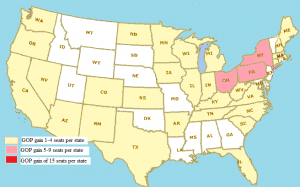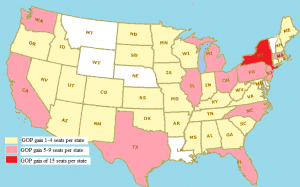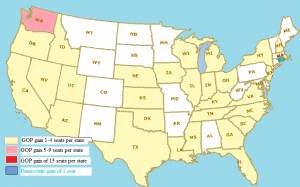Criteria used to estimate GOP House seat gains
Over the past few months, we have continually been refining our criteria to determine whether we think a Democratic held House seat is vulnerable or not. At the present time, we have projected a 76 seat House gain for the GOP based on the following criteria:
(1) An Obama vote of 65% or less;
(2) (For incumbent Democrats), a 2008 re-election percentage of 65% or less;
(3) (For incumbent Democrats), his/her voting record on major legislation (the stimulus, “cap and trade”, raising the national debt; ceiling, and the five healthcare votes taken). We believe that in general, voting against the Democratic agenda a majority of the time insulates an incumbent from defeat, unless the incumbent Democrat voted “Yes” at least once on healthcare reform;
(4) Whether the district has a significant Democratic base vote (minorities, academic liberals, Jewish voters, or government workers). So far, the “Obama plunge” (explained here) has been with Republicans and Independents, and NOT with “base voters.” This means a district meeting the demographic characteristics just mentioned will likely remain Democratic regardless of other factors listed above;
Given these criteria, there are 77 Democrats and one Republican (Joseph Cao in New Orleans) who we believe are vulnerable. 16 of these 77 Democratic seats are open seats due to retirement or defeat in a partisan primary. Because the average Obama vote in those 16 seats was 48%, we are comfortable with our assumption that those seats are Republican pickups. The remaining 61 Democratic incumbents we believe are similarly vulnerable reside in districts that on average voted 53% for Obama. Since this figure was precisely the national average in an election conducted under circumstances extremely favorable to Democrats, we believe that the national mood has changed enough since November 2008 for Republicans to have a chance to pick up those seats as well.
The “Mollohan Effect”
Up until recently, we believed that receiving more than 65% of the vote (or being unopposed) in the 2008 election insulated a Democratic incumbent in his/her 2010 re-election bid. However, the May 11 primary defeat of 28 year incumbent Alan Mollohan (D-West Virginia) shows that 2010 is a totally different ballgame, and that those supposedly safe Democrats have to be included in our analysis. There are 71 Democrats who were previously listed as “safe” who must now be considered in our analysis. What we found in this group was the following:
(1) Four of these Democrats were unopposed in 2008; in these districts, Obama received an average of 58% of the vote;
(2) The remaining 67 Democrats were opposed in 2008 but were re-elected with 65% or more of the vote. In these districts, Obama received an average of 57% of the vote;
Given the fact that the Obama percentage was respectable but not overwhelming in these 71 Democratic held districts, we believe there are vulnerable incumbents to be found in this population. Especially since 63 of the 71 Democrats in this group voted at least once for healthcare reform. Furthermore, in this group, only one Democrat (Gene Taylor of Mississippi) has a perfect conservative record and can logically be considered safe.
Another possible group of vulnerable Democrats
As we mentioned above, Rep. Mollohan’s defeat in a Democratic primary should put to rest the assumption that a near unanimous 2008 re-election percentage protects any Democratic incumbent this year. Additionally, there is one more group of Democrats that we have excluded from consideration who should now be considered – the 13 incumbent Democrats who voted against healthcare reform and a majority of Democratic legislation (stimulus, cap and trade, increasing the national debt ceiling) who may still be vulnerable to a strong challenger. This group of Democrats represents districts that on average gave Obama 47% of the vote, so a Republican challenger in those districts wouldn’t have to attract as much independent support to be victorious.
How many seats could the GOP gain ?
For now, in the absence of evidence to the contrary, we are projecting a 76 seat GOP gain in the House (77 Democratic losses plus the GOP’s losing the House seat in New Orleans). If we were to include the populations of Democrats listed above in our analysis, projected GOP gains under perfect conditions could go as high as 160 seats. A gain of this size suddenly makes John Boehner’s prediction of at least 100 House seats being in play as not so far fetched after all.
We would like to conclude this analysis by graphically showing the following:
(1) The list of seats that we think are in play for the GOP
(2) Where we think the 76 and/or 160 seat landslide would look occur, and
(3) Where the 1994 GOP landslide that resulted in a 50+ seat pickup for the GOP occurred
Would the Democratic retention of the open seat in Pennsylvania affect these assumptions? Though this race is a good illustration of the danger of assuming that every open seat is a GOP pickup, we are not factoring that race into our projections of GOP gains at this point, because this special election contained a unique set of circumstances (contested Democratic primaries, a late surge by Joe Sestak that brought Democrats to the polls, and the fact that the “Obama plunge” applies more to Independents who are unlikely to vote on primary day) that would likely not be repeated in the fall.




Great website…
[…]we like to honor many other internet sites on the web, even if they aren’t linked to us, by linking to them. Under are some webpages worth checking out[…]……
Cool sites…
[…]we came across a cool site that you might enjoy. Take a look if you want[…]……
Blogs ou should be reading…
[…]Here is a Great Blog You Might Find Interesting that we Encourage You[…]……
Sites we Like……
[…] Every once in a while we choose blogs that we read. Listed below are the latest sites that we choose […]……
Related……
[…]just beneath, are numerous totally not related sites to ours, however, they are surely worth going over[…]……
Great website…
[…]we like to honor many other internet sites on the web, even if they aren’t linked to us, by linking to them. Under are some webpages worth checking out[…]……
Digg suggestion…
While checking out Digg yesterday I noticed this…